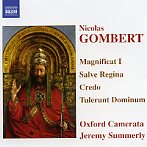Listeners interested in Renaissance choral music in general and the works of Nicolas Gombert in particular will already be familiar with the two excellent recordings of eight Magnificats by the Tallis Scholars (type Q4371 and Q5969 in Search Reviews). If you read those reviews you’ll save me from repeating myself regarding the abundance of rich textures and vibrant–sometimes surprising–harmonies, the flowing polyphony extended over page after non-cadential page, and the poignant evocation of mood relative to texts, all of which characterize Gombert’s best writing. And based on those Tallis Scholars programs and the repertoire heard here, Gombert just didn’t write any second-rate music.
It’s especially gratifying to hear how he manipulates (in the best sense) voicing to create varieties of textures within the same work–the Magnificat and Credo, for instance–which also has the important effect of highlighting the meaning of the words. If you could listen to only one section of one piece, the Et incarnatus est of the Credo (all together 13-plus minutes of sublimity) is a perfect illustration of the qualities mentioned above regarding textures, harmonies, and flowing polyphony. But then, the Tulerunt Dominum meum and Super flumina Babylonis also exhibit those same attributes, one in Gombert’s most masterful eight-part style, the other in four parts.
Gombert also is a master of the dramatic ending, giving us both strong and satisfying harmonic resolutions (especially the Media vita)–and strong and, well, slightly unsettling final chords, namely in the Tulerunt Dominum meum and the appropriately somber, occasionally dark, and very moving Epitaphium (in Josquinum a Prato) that closes the disc. In each of these last two works, the rather open-ended nature of the final (minor) harmonies is consistent with the texts, the one depicting a distraught Mary Magdalene trying to comprehend the empty tomb of Christ, the other expressing the sorrowful and sometimes bitter words of the composer at the loss of his mentor Josquin.
Throughout, the singing by the Oxford Camerata is first rate, with careful attention to the constantly changing balances and to the clarity of the inner lines. The sopranos are particularly lovely, and the women’s plainchant Salve regina is an unexpected treat. The sound is generally fine–except the voices have a bit of a bright, harsh “edge” at louder dynamic levels, a quality that seems to be favored by producers of many British choral recordings (and may be a reflection–literally–of the stone, wood, and glass prevalent in chapels and cathedrals). Strongly recommended. [2/2/2006]
































